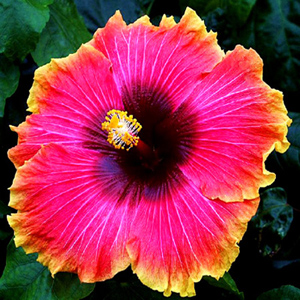Hibiscus Plant Care
How to Care for your Exotic Hibiscus
Hibiscus are good performers, both in the garden and in bright areas inside the house. If they receive just a small amount of care they reward us with many magical blooms throughout the year. Here, in short, is what they need:
 Hibiscus Flower 'Heavy Metal' |
1. Temperature: Most important, a WARM place where their tropical origins are respected. It is often said that hibiscus like much the same conditions as people and with temperature, that is pretty much true. For best results and lots of blooms, hibiscus should be located where the temperature remains between 60-95°F (15-35°C) most of the time. Short periods of either hot or cold will not injure them though they may show their displeasure by shedding a few leaves or dropping some developing flower buds.
If temperatures routinely drop below 50°F (10°C), particularly at night, most growth and blooming will stop until it warms up again. Flower size will become much smaller and the occasional blooms may also be misshapen. For more information on cool weather growing, see Hibiscus Care ~ Wintering Tropical Hibiscus.
Temperatures below freezing will injure hibiscus. Factors such as how cold and for how long, the age of the plant, and whether it is dehydrated determine how extensive the damage. Under 30°F (-1°C) for many hours will most likely kill the plant entirely. Such temperatures should be avoided.
Temperatures over 95°F (35°C) will often cause most flower buds to drop off. Hibiscus can survive temperatures even as high as 115°F (46°C), provided they have adequate water. When the weather is hot, it is best to maintain a steady supply of water to the plant, rather than have it go through wet/dry cycles. For more information, see Hibiscus Care ~ How Much Sun?
2. Watering. Watering is divided into two areas - cold weather watering and hot weather watering. In hot weather hibiscus will use lots of water and prefer a steady supply of it. Avoid flooding the roots or allowing the plant to stand in a saucer full of water for an extended time. Hibiscus will develop droopy leaves in hot weather if they do not have enough water. The cure is simple, provide some water and the leaves will regain their crispness.
 Hibiscus 'Palm Springs' |
3. Feeding: In order to maintain a healthy hibiscus that blooms a lot, you must feed it. Purchase a good quality plant food (HVH Special Blend Hibiscus Fertilizer is the best available anywhere) and use it regularly according to directions on the container. Avoid those labeled SuperBloom. Look at the label for what is often called "minors" such as iron, copper, manganese, and other minerals as these are also good for hibiscus. If you don't like to fertilize, try using a time release product like HVH Recommended Time Release or Osmocote that can last for months with just one application. HVH High Quality Worm Castings mixed into or placed on top of your potting or planting soil give a super nutritional boost to your hibiscus. For more information, see Hibiscus Care ~ Feeding.
4. Pest Control: Defend your hibiscus against insects as necessary. Many insects can be driven away simply by spraying the plant with a water hose or the highly recommended Bug Blaster or placing it in the shower for a few minutes. For specific pest problems there are other safe treatments that a good nursery can advise you about, too. For more information, see Hibiscus Care ~ Pests.
 Hibiscus 'Love Story' |